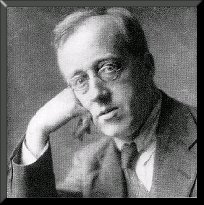Gustav Holst - Biography
Gustav Holst Biography
Gustavus Theodore von Holst (September 21, 1874 – May 25, 1934) was an English composer with Latvian (and some Spanish) roots.
Born in Cheltenham, where he was educated at Pate's Grammar School, he went on to study at the Royal College of Music in London. His best-known work is probably his orchestral suite The Planets, completed in 1916, although the composer himself did not count it as one of his best creations and later often complained that other works were completely eclipsed by it. The Planets (1914–1916) was partly inspired by meditations on his own horoscope/natal chart and dealt with the 'seven influences of destiny and constituents of our spirit.' Holst was especially influenced by a 19th-century astrologer called Raphael, whose book concerning the planets' role in world affairs led Holst to develop the grand vision of the planets that made The Planets such an enduring success.
Holst's relatively small output for the wind band guaranteed him a position as the medium's cornerstone, as seen in innumerable present-day programmes featuring his two Suites for Military Band.
His one work for brass band, A Moorside Suite, remains an important part of the brass band repertoire.
Like many composers, Holst also played a musical instrument, in his case the trombone (a choice dictated by a medical condition that robbed him of the manual dexterity required for more obvious instruments such as the piano).
From 1933 Holst suffered from severe stomach problems. On May 25, 1934 he died of complications, following surgery in London. He is buried in Chichester Catherderal, West Sussex.
His daughter Imogen Holst was also a composer and conductor.
Other works
- The Mystic Trumpeter (1904)
- A Somerset Rhapsody (1907)
- First Suite for Military Band in Eb (1909)
- Chaconne
- Intermezzo
- March
- Beni Mora (Oriental Suite) Op.29 No.1 (1909 – 1910)
- First Dance
- Second Dance
- Finale
- Two Eastern Pictures (1911)
- Second Suite for Military Band in F (1911)
- March: Morris Dance, Swansea Town, Claudy Banks
- Song Without Words 'I'll Love my Love'
- Song of the Blacksmith
- Fantasia on the 'Dargason'
- Psalm 86 H.117 No.2 (Psalmo 86), (1912)
- Choral Hymns from the Rig Veda (1908 – 1912)
- First Group (for women's chorus and orchestra) (H.96)
- Battle Hymn
- To the Unknown God
- Second Group (for chorus and orchestra) (H.98)
- To Varuna (God of the Waters)
- To Agni (God of Fire)
- Funeral Chant
- Third Group (for women's chorus and harp) (H.99)
- Hymn to the Dawn
- Hymn to the Waters
- Hymn to Vena (Sun rising through the mist)
- Hymn of the Travelers
- Fourth Group (for men's chorus and orchestra (H.100)
- Hymn to Sama (the juice of an herb)
- Hymn to Manas (the spirit of a dying man)
- First Group (for women's chorus and orchestra) (H.96)
- Two Eastern Pictures (for women's voices and harp) (H.112)
- Spring
- Summer
- St. Paul's Suite Op.29 No.2 (Finale is another arrangement of 4th movement in Second Suite) (1913)
- Jig
- Ostinato
- Intermezzo
- Finale (The Dargason)
- Hymn to Dionysus Op.31 No.2(H.116) (1913)
- The Hymn of Jesus (1917)
- Ode to Death 1919
- Short Festival Te Deum (H.145) (1919)
- The Perfect Fool Op.39 opera (1918–1922)
- At the Boar's Head (1924)
- Egdon Heath, (1927)
- A Moorside Suite (1928)
- Scherzo
- Nocturne
- March
- The Wandering Scholar opera, (1929 – 1930)
- Hammersmith: Prelude and Scherzo (1930)
- Lyric Movement (1933)
- Brook Green Suite (H.190) (1933)
- Prelude
- Air
- Dance
External link
- Gustav Holst (http://www.gustavholst.info)
This biography is published under the GNU Licence

